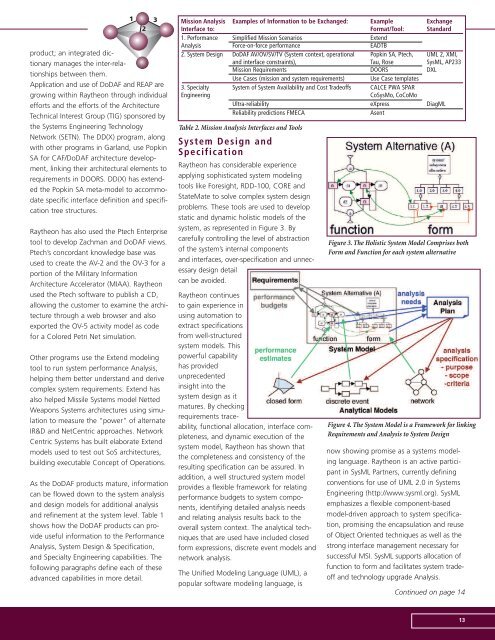TT_Vol3 Issue2 - Raytheon
TT_Vol3 Issue2 - Raytheon
TT_Vol3 Issue2 - Raytheon
Create successful ePaper yourself
Turn your PDF publications into a flip-book with our unique Google optimized e-Paper software.
product; an integrated dictionary<br />
manages the inter-relationships<br />
between them.<br />
Application and use of DoDAF and REAP are<br />
growing within <strong>Raytheon</strong> through individual<br />
efforts and the efforts of the Architecture<br />
Technical Interest Group (TIG) sponsored by<br />
the Systems Engineering Technology<br />
Network (SETN). The DD(X) program, along<br />
with other programs in Garland, use Popkin<br />
SA for CAF/DoDAF architecture development,<br />
linking their architectural elements to<br />
requirements in DOORS. DD(X) has extended<br />
the Popkin SA meta-model to accommodate<br />
specific interface definition and specification<br />
tree structures.<br />
<strong>Raytheon</strong> has also used the Ptech Enterprise<br />
tool to develop Zachman and DoDAF views.<br />
Ptech’s concordant knowledge base was<br />
used to create the AV-2 and the OV-3 for a<br />
portion of the Military Information<br />
Architecture Accelerator (MIAA). <strong>Raytheon</strong><br />
used the Ptech software to publish a CD,<br />
allowing the customer to examine the architecture<br />
through a web browser and also<br />
exported the OV-5 activity model as code<br />
for a Colored Petri Net simulation.<br />
Other programs use the Extend modeling<br />
tool to run system performance Analysis,<br />
helping them better understand and derive<br />
complex system requirements. Extend has<br />
also helped Missile Systems model Netted<br />
Weapons Systems architectures using simulation<br />
to measure the "power" of alternate<br />
IR&D and NetCentric approaches. Network<br />
Centric Systems has built elaborate Extend<br />
models used to test out SoS architectures,<br />
building executable Concept of Operations.<br />
As the DoDAF products mature, information<br />
can be flowed down to the system analysis<br />
and design models for additional analysis<br />
and refinement at the system level. Table 1<br />
shows how the DoDAF products can provide<br />
useful information to the Performance<br />
Analysis, System Design & Specification,<br />
and Specialty Engineering capabilities. The<br />
following paragraphs define each of these<br />
advanced capabilities in more detail.<br />
Mission Analysis Examples of Information to be Exchanged: Example Exchange<br />
Interface to: Format/Tool: Standard<br />
1. Performance Simplified Mission Scenarios Extend<br />
Analysis Force-on-force performance EADTB<br />
2. System Design DoDAF AV/OV/SV/TV (System context, operational Popkin SA, Ptech, UML 2, XMI,<br />
and interface constraints), Tau, Rose SysML, AP233<br />
Mission Requirements DOORS DXL<br />
Use Cases (mission and system requirements) Use Case templates<br />
3. Specialty System of System Availability and Cost Tradeoffs CALCE PWA SPAR<br />
Engineering CoSysMo, CoCoMo<br />
Ultra-reliability eXpress DiagML<br />
Reliability predictions FMECA Asent<br />
Table 2. Mission Analysis Interfaces and Tools<br />
System Design and<br />
Specification<br />
<strong>Raytheon</strong> has considerable experience<br />
applying sophisticated system modeling<br />
tools like Foresight, RDD-100, CORE and<br />
StateMate to solve complex system design<br />
problems. These tools are used to develop<br />
static and dynamic holistic models of the<br />
system, as represented in Figure 3. By<br />
carefully controlling the level of abstraction<br />
of the system’s internal components<br />
and interfaces, over-specification and unnecessary<br />
design detail<br />
can be avoided.<br />
<strong>Raytheon</strong> continues<br />
to gain experience in<br />
using automation to<br />
extract specifications<br />
from well-structured<br />
system models. This<br />
powerful capability<br />
has provided<br />
unprecedented<br />
insight into the<br />
system design as it<br />
matures. By checking<br />
requirements traceability,<br />
functional allocation, interface completeness,<br />
and dynamic execution of the<br />
system model, <strong>Raytheon</strong> has shown that<br />
the completeness and consistency of the<br />
resulting specification can be assured. In<br />
addition, a well structured system model<br />
provides a flexible framework for relating<br />
performance budgets to system components,<br />
identifying detailed analysis needs<br />
and relating analysis results back to the<br />
overall system context. The analytical techniques<br />
that are used have included closed<br />
form expressions, discrete event models and<br />
network analysis.<br />
The Unified Modeling Language (UML), a<br />
popular software modeling language, is<br />
Figure 3. The Holistic System Model Comprises both<br />
Form and Function for each system alternative<br />
Figure 4. The System Model is a Framework for linking<br />
Requirements and Analysis to System Design<br />
now showing promise as a systems modeling<br />
language. <strong>Raytheon</strong> is an active participant<br />
in SysML Partners, currently defining<br />
conventions for use of UML 2.0 in Systems<br />
Engineering (http://www.sysml.org). SysML<br />
emphasizes a flexible component-based<br />
model-driven approach to system specification,<br />
promising the encapsulation and reuse<br />
of Object Oriented techniques as well as the<br />
strong interface management necessary for<br />
successful MSI. SysML supports allocation of<br />
function to form and facilitates system tradeoff<br />
and technology upgrade Analysis.<br />
Continued on page 14<br />
13
















